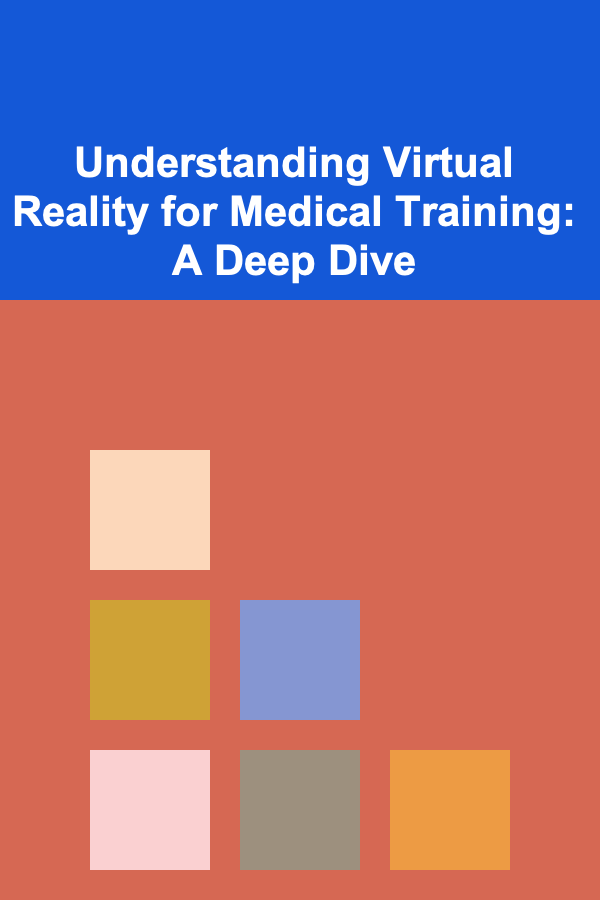
Understanding Virtual Reality for Medical Training: A Deep Dive
ebook include PDF & Audio bundle (Micro Guide)
$12.99$6.99
Limited Time Offer! Order within the next:

Virtual Reality (VR) is rapidly transforming various industries, and medical training is no exception. Its ability to create immersive, interactive, and realistic simulations offers unprecedented opportunities to enhance learning and skill development for healthcare professionals. However, understanding the potential and limitations of VR in medical training requires a comprehensive exploration of its underlying principles, technological advancements, pedagogical applications, and ethical considerations. This article delves into the multifaceted aspects of VR in medical training, providing a detailed overview of its current state and future prospects.
What is Virtual Reality? A Foundation for Understanding
At its core, Virtual Reality is a technology that uses computer-generated environments to simulate a realistic experience for the user. This experience typically involves visual, auditory, and sometimes haptic (touch) feedback, creating a sense of presence -- the feeling of actually being in the virtual world. The level of immersion, interactivity, and realism are key factors determining the effectiveness of a VR experience. Here's a breakdown of these core concepts:
- Immersion: Refers to the extent to which the VR system can isolate the user from the real world and engage their senses within the virtual environment. High immersion involves blocking out external distractions through headsets (HMDs) and providing realistic sensory stimuli.
- Interactivity: Describes the user's ability to interact with the virtual environment and influence events within it. This can include manipulating objects, navigating the virtual space, and communicating with virtual characters. High interactivity allows for active learning and skill development.
- Realism: Relates to the degree to which the virtual environment mimics the real world in terms of visual fidelity, physics, and behavioral responses. While photorealism is not always necessary, a sufficient level of realism is crucial for transfer of training to real-world scenarios.
Different types of VR systems exist, each offering varying levels of immersion and interaction:
- Non-Immersive VR (Desktop VR): Users interact with a virtual environment displayed on a computer screen using a mouse and keyboard. While less immersive, it's a cost-effective entry point for basic training simulations.
- Semi-Immersive VR: Uses large projection screens or multiple monitors to create a more immersive experience. This can be suitable for training involving teamwork or large-scale scenarios.
- Fully Immersive VR: The most immersive type, utilizing head-mounted displays (HMDs) to completely enclose the user's field of vision. This allows for the most realistic and engaging training experiences. Examples include systems like Oculus Rift, HTC Vive, and Valve Index.
The Advantages of VR in Medical Training: A Paradigm Shift
The integration of VR into medical training offers a multitude of advantages over traditional methods, addressing several key limitations and enhancing the learning experience in profound ways:
1. Risk-Free Environment for Practice and Error
Perhaps the most significant advantage is the ability to practice complex procedures and handle critical situations without any risk to real patients. Medical errors are a major concern in healthcare, and VR provides a safe space for trainees to make mistakes, learn from them, and refine their skills without jeopardizing patient safety. Surgical simulations, emergency response scenarios, and diagnostic challenges can all be practiced repeatedly in a virtual environment.
2. Enhanced Procedural Skills and Dexterity
VR allows for repeated practice of intricate procedures, improving hand-eye coordination, dexterity, and spatial reasoning. Surgical simulations, for example, can provide realistic haptic feedback, allowing trainees to feel the resistance of tissues and the nuances of instrument manipulation. This hands-on experience is crucial for developing the muscle memory and technical skills necessary for performing real-world procedures.
3. Improved Anatomical Understanding
VR provides an unparalleled opportunity to explore the human anatomy in three dimensions. Trainees can virtually dissect organs, examine internal structures from various angles, and visualize complex anatomical relationships in a way that is simply not possible with textbooks or cadavers. Interactive anatomical models can be manipulated and explored, fostering a deeper understanding of the human body.
4. Standardized Training and Assessment
VR simulations can be standardized to ensure that all trainees receive the same level of instruction and are exposed to the same critical scenarios. This eliminates the variability inherent in traditional training methods, where exposure to different cases and procedures can depend on the availability of patients and the preferences of instructors. Furthermore, VR provides objective metrics for assessing performance, allowing for more accurate and consistent evaluation of skills.
5. Increased Engagement and Motivation
The immersive and interactive nature of VR can significantly increase trainee engagement and motivation. Gamified training scenarios and realistic simulations can make learning more enjoyable and memorable, leading to better retention of information and improved skill development. The ability to track progress and receive immediate feedback further enhances motivation and encourages continuous improvement.
6. Accessibility and Flexibility
VR training can be accessed remotely, allowing trainees to learn from anywhere in the world, at any time. This is particularly beneficial for institutions with limited resources or for trainees who are unable to attend traditional training sessions. The flexibility of VR training also allows for personalized learning, with trainees able to progress at their own pace and focus on areas where they need the most improvement.
7. Cost-Effectiveness in the Long Run
While the initial investment in VR equipment and software can be significant, VR training can be cost-effective in the long run. It reduces the need for expensive cadavers, animal models, and operating room time. Furthermore, by improving trainee proficiency and reducing medical errors, VR can contribute to significant cost savings in healthcare.
Applications of VR in Medical Training: A Diverse Spectrum
The versatility of VR technology allows it to be applied to a wide range of medical training scenarios. Here are some key areas where VR is making a significant impact:
1. Surgical Simulation
Surgical simulation is one of the most prominent applications of VR in medical training. VR surgical simulators allow trainees to practice a variety of procedures, from basic laparoscopic skills to complex open surgeries. These simulators often incorporate haptic feedback, providing a realistic sense of touch and resistance. They can also simulate complications and emergencies, allowing trainees to develop their problem-solving skills in a safe environment. Examples include simulations for laparoscopic cholecystectomy, appendectomy, and hernia repair, as well as more complex procedures such as coronary artery bypass grafting and total knee arthroplasty.
2. Anatomy Education
VR offers a revolutionary approach to anatomy education. Instead of relying on static textbooks or cadavers, trainees can explore interactive 3D anatomical models that can be rotated, dissected, and manipulated. VR anatomy applications often include detailed labeling of anatomical structures and interactive quizzes to test knowledge. The ability to visualize anatomical relationships in three dimensions enhances understanding and retention, making learning more engaging and effective. Furthermore, VR can be used to visualize patient-specific anatomy based on medical imaging data, allowing for personalized surgical planning and training.
3. Medical Procedures Training
VR can be used to train healthcare professionals in a variety of medical procedures, such as intubation, central line insertion, and lumbar puncture. These simulations provide a realistic environment for practicing the steps involved in each procedure and developing the necessary technical skills. They can also simulate complications, allowing trainees to learn how to manage adverse events in a controlled setting. Haptic feedback is particularly important in these simulations, providing a realistic sense of touch and resistance.
4. Emergency Response Training
VR is an ideal tool for training healthcare professionals in emergency response. VR simulations can recreate a variety of emergency scenarios, such as cardiac arrest, trauma, and stroke. Trainees can practice their assessment skills, triage patients, and perform life-saving interventions in a realistic and stressful environment. VR emergency response simulations can also be used to train teams of healthcare professionals, improving communication and coordination during critical events. The ability to replay and analyze performance after the simulation allows for continuous improvement.
5. Patient Communication and Empathy Training
VR can be used to improve patient communication and empathy skills. VR simulations can allow healthcare professionals to experience the world from the perspective of a patient with a specific condition, such as hearing loss, vision impairment, or anxiety. This can help them to develop a better understanding of the challenges faced by patients and improve their communication skills. VR can also be used to train healthcare professionals in how to deliver bad news, manage difficult conversations, and provide emotional support to patients and their families.
6. Rehabilitation and Therapy
VR is increasingly being used in rehabilitation and therapy to help patients recover from injuries or illnesses. VR simulations can provide a motivating and engaging environment for patients to practice their motor skills, improve their balance, and reduce their pain. VR therapy can be used to treat a variety of conditions, such as stroke, spinal cord injury, and traumatic brain injury. The interactive nature of VR allows for personalized therapy programs that can be tailored to the individual needs of each patient.
7. Mental Health Training
VR is proving to be a valuable tool in mental health training. Simulations can be created to mimic the experiences of patients suffering from conditions like anxiety, PTSD, or schizophrenia. This allows trainees to gain a better understanding of these conditions and develop more effective treatment strategies. Furthermore, VR can be used to practice therapeutic techniques in a safe and controlled environment.
Challenges and Limitations: Addressing the Hurdles to Widespread Adoption
Despite its numerous advantages, VR in medical training faces several challenges and limitations that need to be addressed to ensure its widespread adoption and effective implementation:
1. High Initial Cost
The cost of VR equipment and software can be a significant barrier to entry, particularly for smaller institutions and developing countries. High-end VR headsets, powerful computers, and specialized simulation software can be expensive. However, as VR technology becomes more mainstream, the cost is expected to decrease over time.
2. Technical Expertise Required
Implementing and maintaining VR systems requires technical expertise. Institutions need to have staff who are trained in the installation, configuration, and troubleshooting of VR equipment and software. Developing custom VR simulations also requires specialized programming and design skills. This can be a challenge for institutions that lack the necessary technical resources.
3. Motion Sickness and Discomfort
Some users may experience motion sickness or other forms of discomfort when using VR headsets. This is often due to a mismatch between the visual stimuli and the vestibular system, which is responsible for balance. Motion sickness can be minimized by using high-quality VR headsets with high refresh rates, optimizing the virtual environment to reduce latency, and providing users with breaks during long training sessions. Proper user onboarding and gradual acclimatization can also help to reduce motion sickness.
4. Limited Haptic Feedback
While VR technology has made significant progress in haptic feedback, it is still limited in its ability to replicate the full range of tactile sensations experienced in real-world medical procedures. Developing more advanced haptic feedback systems is an ongoing area of research. The realism of surgical simulations, in particular, is highly dependent on the quality of haptic feedback.
5. Lack of Standardized Curricula and Validation
There is a lack of standardized curricula and validation studies for VR medical training programs. This makes it difficult to compare the effectiveness of different VR systems and to determine the optimal way to integrate VR into existing medical training programs. More research is needed to develop evidence-based guidelines for VR medical training.
6. Transfer of Training
Ensuring that skills learned in VR translate effectively to real-world clinical practice is a critical challenge. VR simulations need to be designed to accurately reflect the complexities and challenges of real-world scenarios. Transfer of training can be enhanced by providing trainees with opportunities to practice their skills in real-world settings after completing VR training.
7. Ethical Considerations
The use of VR in medical training raises several ethical considerations. It is important to ensure that VR simulations are used responsibly and ethically, and that trainees are not misled or harmed by their use. Issues such as data privacy, informed consent, and the potential for bias in VR simulations need to be carefully considered.
Future Trends: The Evolving Landscape of VR in Medical Training
The future of VR in medical training is bright, with ongoing technological advancements and increasing adoption across various medical specialties. Here are some key trends that are shaping the future of VR in this field:
1. Enhanced Haptic Feedback Systems
Research and development efforts are focused on creating more sophisticated haptic feedback systems that can provide a wider range of tactile sensations, including texture, temperature, and vibration. This will significantly enhance the realism of VR simulations and improve the transfer of training to real-world procedures.
2. Integration of Artificial Intelligence (AI)
AI is being integrated into VR medical training to provide personalized feedback, adaptive learning, and intelligent tutoring. AI algorithms can analyze trainee performance in VR simulations and provide targeted feedback on areas for improvement. AI can also be used to create more realistic and dynamic virtual environments that respond to the trainee's actions.
3. Increased Use of Augmented Reality (AR)
Augmented Reality (AR) is being used in conjunction with VR to create mixed reality training environments. AR overlays digital information onto the real world, allowing trainees to practice procedures on real patients or mannequins while receiving real-time guidance and feedback from a VR system. This approach can provide a more realistic and engaging training experience.
4. Development of More Realistic and Detailed Virtual Environments
Advances in computer graphics and simulation technology are leading to the development of more realistic and detailed virtual environments. This includes more accurate anatomical models, realistic tissue behavior, and realistic simulation of physiological processes. The goal is to create VR simulations that are indistinguishable from real-world experiences.
5. Expansion to New Medical Specialties
VR is being adopted by an increasing number of medical specialties, including psychiatry, neurology, and rehabilitation. VR simulations are being developed to train healthcare professionals in a wider range of skills, from diagnosing mental health disorders to managing neurological conditions.
6. Remote Collaboration and Training
VR is enabling remote collaboration and training, allowing healthcare professionals from different locations to work together in a virtual environment. This can be particularly useful for training in rare or complex procedures, or for providing mentorship and guidance to trainees in remote areas.
7. Integration with Electronic Health Records (EHRs)
VR is being integrated with Electronic Health Records (EHRs) to provide trainees with access to patient data and medical history during simulations. This allows trainees to practice their clinical decision-making skills in a more realistic context.
Conclusion: Embracing the Potential of VR for a Future of Medical Excellence
Virtual Reality holds immense promise for transforming medical training and ultimately improving patient care. By providing a safe, engaging, and effective learning environment, VR can help to enhance the skills and knowledge of healthcare professionals and reduce medical errors. While challenges remain, ongoing technological advancements and increasing adoption suggest that VR will play an increasingly important role in medical education in the years to come. By embracing the potential of VR and addressing its limitations, we can pave the way for a future of medical excellence.

How to Protect Your Furniture and Floors from Pet Damage
Read More
How to Renovate Your Basement and Add Extra Living Space
Read More
How to Repurpose Household Items for Organizational Tools
Read More
How to Set Up a Holiday Photo Wall to Capture Seasonal Memories
Read More
How to Use Green Soundproofing Materials for an Eco-Friendly Home
Read More
How to Use Your Native Language to Make Money
Read MoreOther Products

How to Protect Your Furniture and Floors from Pet Damage
Read More
How to Renovate Your Basement and Add Extra Living Space
Read More
How to Repurpose Household Items for Organizational Tools
Read More
How to Set Up a Holiday Photo Wall to Capture Seasonal Memories
Read More
How to Use Green Soundproofing Materials for an Eco-Friendly Home
Read More